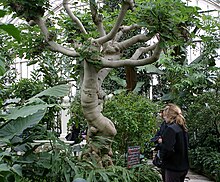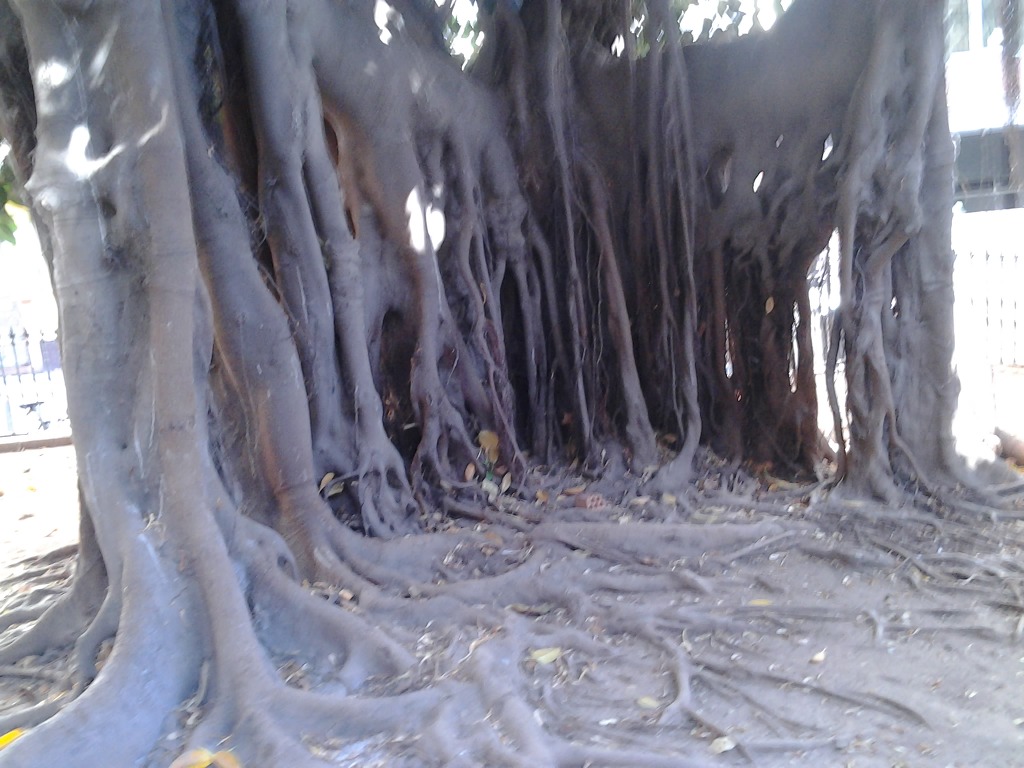"Figs" redirects here. For the acronym, see FIGS. "Fig trees" redirects here. For the 2009 film, see Fig Trees. Ficus (//[2][3] or //[4][5] is a genus of about 850 species of woody trees, shrubs, vines,epiphytes and hemiepiphytes in the familyMoraceae. Collectively known as fig trees or figs, they are native throughout the tropics with a few species extending into the semi-warm temperatezone. The Common Fig (F. carica) is a temperate species native to southwest Asia and theMediterranean region (from Afghanistan to Portugal), which has been widely cultivated from ancient times for its fruit, also referred to as figs. The fruit of most other species are also edible though they are usually of only local economic importance or eaten asbushfood. However, they are extremely important food resources for wildlife. Figs are also of considerable cultural importance throughout the tropics, both as objects of worship and for their many practical uses.
Description[edit]

Aerial root that may eventually provide structural support
윗 가지에서 마치 수염이 아래로 자라듯이 뻗어 내리다가 땅에 땋으면 땅을 파고 들어가서 시간이 지나면서 또 다른 나무의 한 줄기 같이 성장하게 됩니다.
Ficus is a pan-tropical genus of trees, shrubs and vines occupying a wide variety of ecological niches; most are evergreen, but some deciduous species are endemic to areas outside of the tropics and to higher elevations.[6] Fig species are characterized by their unique inflorescenceand distinctive pollination syndrome, which utilizes wasp species belonging to the Agaonidae family for pollination.
The specific identification of many of the species can be difficult, but figs as a group are relatively easy to recognize.[7] Many have aerial roots and a distinctive shape or habit, and their fruits distinguish them from other plants. The fig fruit is an enclosed inflorescence, sometimes referred to as a syconium, an urn-like structure lined on the inside with the fig's tiny flowers. The unique fig pollination system, involving tiny, highly specific wasps, known as fig wasps that enter viaostiole these sub-closed inflorescences to both pollinate and lay their own eggs, has been a constant source of inspiration and wonder to biologists.[8] Finally, there are three vegetative traits that together are unique to figs. All figs possess a white to yellowish latex, some in copious quantities; the twig has paired stipulesor a circular stipule scar if the stipules have fallen off; and the lateral veins at the base of the leaf are steep, forming a tighter angle with the midrib than the other lateral veins, a feature referred to as "tri-veined".
There are no unambiguous older fossils of Ficus. However, current molecular clock estimates indicate that Ficus is a relatively ancient genus being at least 60 million years old,[8] and possibly as old as 80 million years. The main radiation of extant species, however, may have taken place more recently, between 20 and 40 million years ago.
Some better known species that represent the diversity of the genus include the Common Figwhich is a small temperate deciduous tree whose fingered fig leaf is well known in art andiconography; the Weeping Fig (F. benjamina) a hemi-epiphyte with thin tough leaves on pendulous stalks adapted to its rain forest habitat; the rough-leaved sandpaper figs from Australia; theCreeping Fig (F. pumila), a vine whose small, hard leaves form a dense carpet of foliage over rocks or garden walls.
Moreover, figs with different plant habits have undergone adaptive radiation in differentbiogeographic regions, leading to very high levels of alpha diversity. In the tropics, it is quite common to find that Ficus is the most species-rich plant genus in a particular forest. In Asia as many as 70 or more species can co-exist.[9] Ficus species richness declines with an increase in latitude in both hemispheres.[10][11]
워낙 큰 나무여서 특수렌즈를 사용한 카메라가 아니고는 나무의 전체 모습을
잡을수가 없어 아쉬운대로 부분적인 모습만으로도 그 기괴한 모습을 볼수밗에
없어 아쉬움이 듭니다.
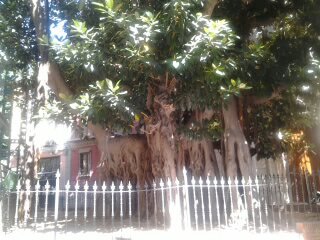
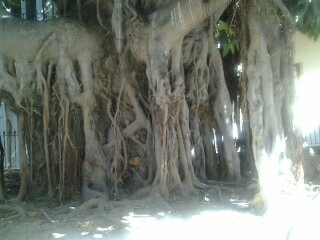


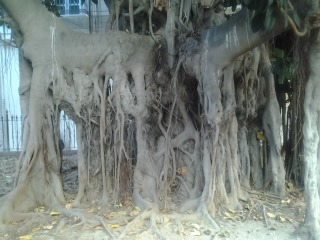
워낙 큰 나무여서 특수렌즈를 사용한 카메라가 아니고는 나무의 전체 모습을
잡을수가 없어 부분적인 모습만으로도 그 기괴한 모습을 볼수밗에
없어 아쉬움이 듭니다.



